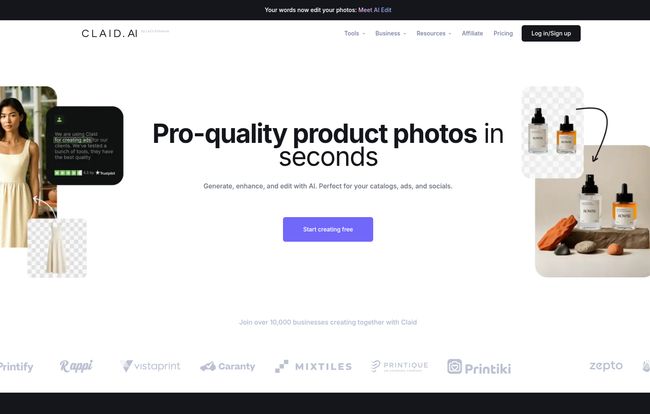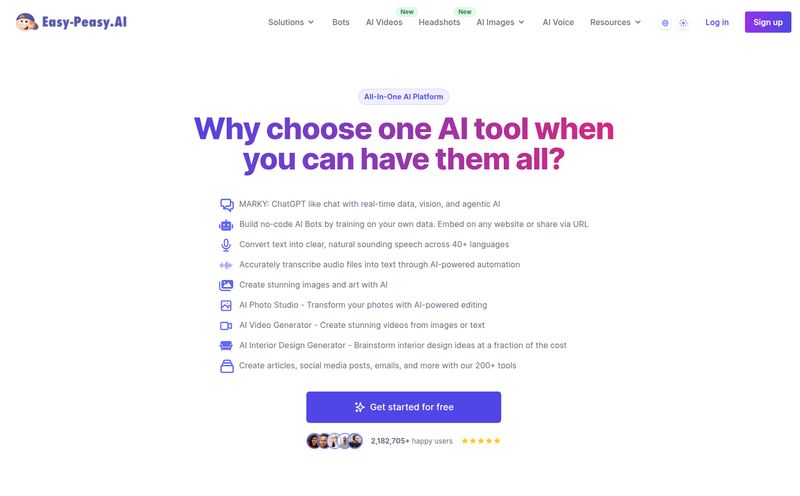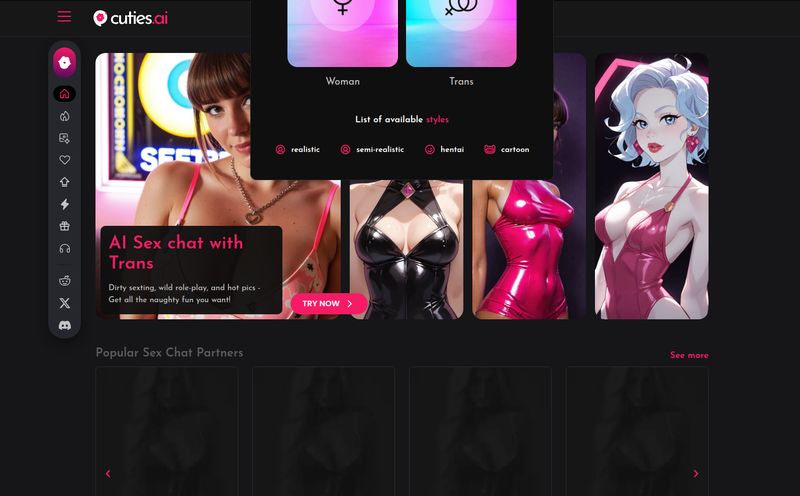If you’ve ever run an eCommerce store or managed PPC campaigns for one, you know the soul-crushing grind of product photography. You either spend a small fortune on a professional photographer for every single SKU, or you spend endless weekends in a DIY light-box setup, fighting with shadows and trying to make a $10 gadget look like a million bucks. The result? Inconsistent images, wasted time, and a nagging feeling that your product pages could be converting so much better.
I’ve been in these trenches for years. I’ve seen beautiful SEO strategies and perfectly targeted ad campaigns fall flat because the product images just… sucked. They were low-res, poorly lit, or sitting on a sad, grey background that screamed “amateur hour.”
So when I started hearing the buzz about AI tools that promised to fix all this, my ears perked up. The latest one to cross my desk is Claid.ai. It calls itself an “all-in-one AI studio,” which sounds impressive, but we’ve all been burned by marketing fluff before. So, I rolled up my sleeves and decided to see if it’s genuinely a game-changer or just another shiny object.
So, What Exactly is Claid.ai Anyway?
At its core, Claid.ai isn't just another photo editor like Photoshop or Canva. It's a generative AI platform built specifically for the chaos of product marketing. Think of it less as a tool and more as a tireless digital intern who’s a wizard at photography, editing, and staging. You give it a plain, boring picture of your product—maybe one you snapped on your phone—and it can place it in a sun-drenched Tuscan villa, a minimalist modern kitchen, or a lush forest scene. All in a few clicks.
The whole idea is to automate the entire image creation pipeline. From cleaning up shoddy supplier photos to generating brand-new lifestyle shots for your next ad campaign, it aims to handle the heavy lifting. This promise of “pro-quality product photos in seconds” is a mighty big one, but the potential is undeniable. We're talking about democratizing the kind of high-end imagery that used to be reserved for brands with deep pockets.

Visit Claid.ai
The Features That Made Me Look Twice
A feature list is just a list until you see how it solves a real problem. Claid.ai has a few tricks up its sleeve that address some of the biggest headaches in eCommerce.
AI Scene Creation: Your Product’s New Home
This is the showstopper. We all know lifestyle shots convert better than sterile, white-background images. They help the customer visualize the product in their own life. But creating them is a pain. Claid’s AI Scene Creation lets you upload your product and then generate a completely new, photorealistic scene around it. Want to sell a new coffee blend? Poof, there it is on a rustic wooden table next to a steaming mug and some croissants. Selling a skincare product? Now it's sitting on a chic marble vanity. This is miles better than scrolling through stock photo sites, trying to find an image that kinda-sorta fits your brand, and then Photoshopping your product in badly.
The “Fix-It” Crew: Enhancement, Upscaling, and More
I once had a client in the dropshipping space who would get these tiny, pixelated product images from their supplier. They looked awful on their Shopify store and even worse in Google Shopping ads. Claid’s enhancement tools are basically a rescue mission for images like these. The Resolution Upscaling can take a blurry image and make it sharp and clear, while the AI Color Correction can fix weird lighting and ensure all your product photos have a consistent look and feel. It’s the kind of quality control that builds trust with customers. It just makes you look more professional.
The API: Where Things Get Really Interesting for Big Players
Okay, for my fellow tech and data nerds, this is the good stuff. While the web interface is great for one-off edits or smaller batches, the Claid API is built for scale. Imagine having thousands of SKUs and needing to create seasonal campaigns for all of them. Or running a marketplace where vendors upload their own photos, all with different qualities and backgrounds. The API lets you programmatically clean up, enhance, and even generate new lifestyle shots for every single product that enters your system. The website claims developers love it, and I can see why. This is how you automate your visual merchandising at a massive scale.
The Good, The Bad, and The AI
No tool is perfect, right? After playing around with it, here’s my honest breakdown of where Claid.ai truly excels and where you might want to pump the brakes.
Where It Shines: Saving Your Sanity (and Budget)
The most immediate win here is efficiency. Claid’s site throws around a stat:
“Onboard sellers faster with 80% reduction in editing costs.”
I believe it. The hours you save by not having to manually remove backgrounds or tweak colors for hundreds of photos add up fast. For an SEO guy like me, better images mean better on-page engagement, which Google loves. For my CPC colleagues, more compelling ad creative means higher Click-Through Rates (CTR) and a better Quality Score, which lowers your ad spend. It's a direct line from good images to a healthier bottom line. The consistency it provides across an entire product catalog is also a subtle but powerful branding tool.
The Trade-offs: When to Keep a Human in the Loop
Now, let's be balanced. The biggest potential downside is the classic AI dilemma: creative control. If your brand has an extremely specific, avant-garde aesthetic, you might find the AI’s suggestions a bit generic at times. It’s brilliant for clean, commercial looks, but it’s not an art director. It's a tool, and you still need a good eye to guide it. There's also teh risk that if everyone starts using the same AI tools, a certain 'sameness' could creep into eCommerce visuals. The key is to use the generation features as a starting point and then use the editing tools to add your own brand’s unique flavor. For very high-stakes hero images, you may still want a human photographer. But for the other 95% of your product catalog? Claid is a workhorse.
Let's Talk Money: A Quick Look at Claid.ai Pricing
Pricing is always the million-dollar question. Claid.ai uses a freemium model that seems pretty well-thought-out. Here’s how I see the tiers:
| Plan | Price (Billed Yearly) | Who It's For |
|---|---|---|
| Free Trial | $0 | The curious and the skeptical. It's a generous trial that lets you properly kick the tires on the Pro features before committing. Perfect for testing on a small batch of your products. |
| Essentials | $9/month | The solopreneur, the Etsy seller, or the small business just getting started. It gives you a good amount of AI Fashion Model generations and access to the core editing tools. |
| Pro | $45/month | This seems to be the sweet spot for growing eCommerce businesses or small marketing agencies. You get more credits, more advanced AI models, and crucial features like background removal. |
| Business | Custom | The big leagues. This is for large retailers, marketplaces, and anyone who needs the full power of the API, dedicated support, and advanced customization. |
The credit system for generations and edits is pretty standard for AI tools. It’s a fair way to price based on usage, so you’re not paying for power you don't need.
Frequently Asked Questions About Claid.ai
I've seen a few common questions pop up, so let's tackle them head-on.
- Is AI really good enough for professional product photography?
- For a huge chunk of it, yes. For creating clean, consistent catalog images, lifestyle mockups for social media, and ad creatives, it's fantastic. It might not replace a high-concept brand photoshoot, but it automates the 90% of visual work that consumes the most time and money.
- Do I own the images I create with Claid.ai?
- Yes. According to their FAQs, you own the rights to the final edited or generated images, which is super important for commercial use. You can use them on your website, in ads, on social media—wherever you need them.
- How many images can I actually process?
- This depends entirely on your plan. The pricing page shows a breakdown of monthly credits for different features, like 'AI Image Generations' or 'AI Edit'. The Free trial is a great way to gauge how many credits you might use in a typical month.
- What’s the difference between AI Edit and AI Generations?
- Think of it this way: AI Edit improves an existing photo (upscaling, color correction, background removal). AI Generations creates a brand new image or scene around your product. Editing fixes what you have; generating creates what you don't.
- Is there a steep learning curve?
- For the web-based editor, not at all. It's very intuitive. If you've used any modern web app, you'll feel right at home. The API, naturally, requires some technical knowledge to integrate, but that's to be expected.
My Final Verdict: Is Claid.ai Worth It?
So, here’s my final take. Claid.ai isn't just another tool; it’s a genuine shift in how we can approach visual commerce. It takes the most tedious, time-consuming, and often expensive parts of product photography and puts them on autopilot. It's an equalizer, giving smaller brands the power to create visuals that can compete with the big dogs.
Is it going to put every commercial photographer out of a job? No. But is it going to save countless hours and boost conversion rates for thousands of online businesses? Absolutely. If you’re in the eCommerce world and you're not at least experimenting with tools like this, you're willingly leaving money and time on the table. Give the free trial a spin. I have a feeling you’ll be impressed.
Reference and Sources
- Claid.ai Official Website
- Claid.ai Pricing Page
- How Product Photography Affects eCommerce Conversion Rates (WPExplorer)



